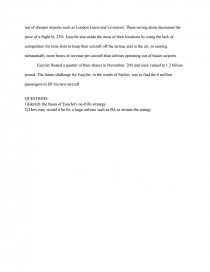Easy Jet - No Frills Strategy
Essay by Nicolas • November 7, 2011 • Case Study • 462 Words (2 Pages) • 2,656 Views
EasyJet's "no frills strategy"
Launched in 1995 , easyJet were seen as the brash young upstart of the European airline industry and widely tipped to fail. In 2001, this Luton-based airline has done more than survive. From a strart point of 6 hired planes working one route, by 2000 they had nineteen fully owned aircraft flying four bases to 16 cites . By 2004, they planned to have 44 Boeing 737 operating their low-price routes.
EasyJet had largely seen off the big national airlines such as British Airways' Co and KLM's Buzz operations that tried to complete alongside them in the European low-price, no-frills niche. Debonair went bust in 1999 when they tried to expand too fast. Ryanair remained easyJet's most closely competitive rival.
Steilos Haji-Ioannou, founder of EasyJet, explain that their was 'based on the belief that demand for short-haul air transport is price elastic- in simple English, if you reduce your price , more people will fly". EasyJet forces the consumer to consider the wider implications of purchasing luxury" The question is not should I fly BA or EasyJet to Nice , it's should be I fly BA to Nice or buy another pair of jeans"
Beneath the surface of EasyJet cosmetic cost saving of not offering free in-flight refreshments or different first, business and economy classes, is a philosophy of cost saving that permeates through the whole company, from its office to its no-ticket flight. For example, EasyJet had not entered the market for connecting flight and simply transported customers from A to B and back again. Consequently, they were able to dispense with costly ticketing procedures along with the ticket vendors such as travel agents. EasyJet's customers simply ring the number on the side of their aircraft, or increasingly access their website and book by credit cards. Customers them checking with a code , not a ticket. Air crew pick up rubbish from each flight in plastic bags. The absence of the need for connections also allowed EasyJet to operate out of cheaper airports such as London Luton and Liverpool. These saving alone decreased the price of a flight by 25%. EasyJet also made the most of their locations by using the lack of competition for time slots to keep their aircraft off the tarmac and in the air, so earning substantially more hours of revenue per aircraft than airlines operating out of busier airports.
EasyJet floated a quarter of their shares in November 200 and were valued at 1.2 billion pound. The future challenge for EasyJet, in the words of Stelios, was to find the 6 million passengers to fill his new aircraft
QUESTIONS:
1)Identify the bases of EasyJet's no-frills strategy
2) How easy would it be for a large airlines such as BA to imitate the stategy
...
...

